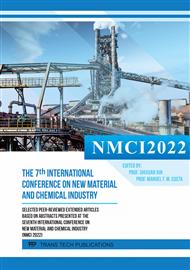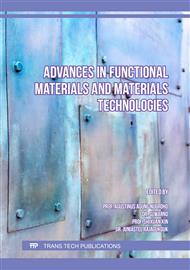[1]
Y. Cai, H. Jiang, J. Yu, B. Tu, S. Liu, Mechanical properties test and mesoscopic numerical simulation of cement-solidified coastal aeolian sand, Chinese J. Geot. Eng. 38 (2016) 1973-1980.
Google Scholar
[2]
E. Mengue, H. Mroueh, L. Lancelot, R. M. Eko, Mechanical Improvement of a Fine-Grained Lateritic Soil Treated with Cement for Use in Road Construction, J. Mater. Civ. Eng. 29 (2017) 04017206.
DOI: 10.1061/(asce)mt.1943-5533.0002059
Google Scholar
[3]
Y.F. Li, Study on the solidification effect of cement and soil solidifying agent on dredged sludge, Southwest University of Science and Technology, (2019).
Google Scholar
[4]
Q. Wu, Y. Wu, W. Tong, H. Ma, Utilization of nickel slag as raw material in the production of Portland cement for road construction, Constr. Build. Mater. 193 (2018) 426-434.
DOI: 10.1016/j.conbuildmat.2018.10.109
Google Scholar
[5]
G. L. Golewski, Evaluation of morphology and size of cracks of the Interfacial Transition Zone (ITZ) in concrete containing fly ash (FA), J. Hazard. Mater. 357 (2018) 298-304.
DOI: 10.1016/j.jhazmat.2018.06.016
Google Scholar
[6]
X.M. Nie, Y.C. An, Study of Synthesis and Properties of Low Temperature Curing Agent for Epoxy Resin, Green. Build. 2 (2006) 22-24.
Google Scholar
[7]
Y. Gao, M. Gao, S. Yin, Study on Static Properties of Polyurethane-cured Sea Sand, Rock. Soil. Mech. 40 (2019) 231-236.
Google Scholar
[8]
C.H. Zhang, Z.M. Chen, Z.Z. Wang, Microwave synthesis of epoxy resin curing agent at low temperature and its properties, Polymers. 39 (2011) 21-23.
Google Scholar
[9]
J. Liu, Y. Bai, Z. Song, D. P. Kanungo, Y. Wang, F. Bu, Z. Chen, X. Shi, Study on engineering properties of sandy soil improved by OPS curing agent, Constr. Build. Mater. 2020, 253.
Google Scholar
[10]
S. Rezaeimalek, J. Huang, S. Bin-Shafique, Evaluation of curing method and mix design of a moisture activated polymer for sand stabilization, Constr. Build. Mater. 146 (2017) 210-220.
DOI: 10.1016/j.conbuildmat.2017.04.093
Google Scholar
[11]
A. Behnood, Soil and clay stabilization with calcium- and non-calcium-based additives: A state-of-the-art review of challenges, approaches and techniques, Transp. Geotech. 17 (2018) 14-32.
DOI: 10.1016/j.trgeo.2018.08.002
Google Scholar
[12]
C. A. Anagnostopoulos, P. Kandiliotis, M. Lola, S. Karavatos, Improving Properties of Sand Using Epoxy Resin and Electrokinetics, Geotech. Geol. Eng. 32 (2014) 859-872.
DOI: 10.1007/s10706-014-9763-6
Google Scholar
[13]
C. A. Anagnostopoulos, T. T. Papaliangas, Experimental Investigation of Epoxy Resin and Sand Mixes, J. Geotech. Geol. Eng. 138 (2012) 841-849.
DOI: 10.1061/(asce)gt.1943-5606.0000648
Google Scholar
[14]
C. A. Anagnostopoulos, G. Sapidis, Mechanical behaviour of epoxy resin-grouted sand under monotonic or cyclic loading, Geotech. Lett. 7 (2017) 298-303.
DOI: 10.1680/jgele.17.00063
Google Scholar
[15]
H. Jin, B.Q. Yang, Fracture toughness and surface morphology of polysulfone-modified epoxy resin, J. Ind. Eng. Chem. 25 (2015) 9-11.
Google Scholar
[16]
N. F. Ariffin, M. W. Hussin, A. R. Mohd Sam, M. A. R. Bhutta, N. H. Abd. Khalid, J. Mirza, Constr. Strength properties and molecular composition of epoxy-modified mortars, Build. Mater. 94 (2015) 315-322.
DOI: 10.1016/j.conbuildmat.2015.06.056
Google Scholar
[17]
F.L. Jin, X. Li, S.J. Park, Synthesis and application of epoxy resins: A review, J. Ind. Eng. Chem. 29 (2015) 1-11.
Google Scholar
[18]
A. K. Kumar, A. B. Arumugam, D.M. Reddy, P.E. Sudhagar, P. Anbumani, M. K. Kassa, D. Agarwal. Prediction of influences of size and locations of delamination on dynamic characteristics of laminated composite plate using particle swarm optimization and artificial neural network, Polym. Compos. 43 (2022) 3398-3411.
DOI: 10.1002/pc.26624
Google Scholar
[19]
W. Ferdous, A. Manalo, T. Aravinthan, G. Van Erp, Properties of epoxy polymer concrete matrix: Effect of resin-to-filler ratio and determination of optimal mix for composite railway sleepers, Constr. Build. Mater.124 (2016) 287-300.
DOI: 10.1016/j.conbuildmat.2016.07.111
Google Scholar
[20]
W. Ferdous, A. Manalo, H. S. Wong, R. Abousnina, O. S. AlAjarmeh, Y. Zhuge, P. Schubel, Optimal design for epoxy polymer concrete based on mechanical properties and durability aspects, Constr. Build. Mater. 232 (2020) 117229.
DOI: 10.1016/j.conbuildmat.2019.117229
Google Scholar
[21]
S. Patil, D.M. Reddy, Damage Identification in Hemp Fiber (Cannabis sativa) Reinforced Composite Plates Using MAC and COMAC Correlation Methods: Experimental Study, J. Nat. Fibers. 19 (2022) 1-16.
DOI: 10.1080/15440478.2020.1764449
Google Scholar
[22]
M. Lettieri, M. Frigione, Effects of humid environment on thermal and mechanical properties of a cold-curing structural epoxy adhesive, Constr. Build. Mater. 30 (2012) 753-760.
DOI: 10.1016/j.conbuildmat.2011.12.077
Google Scholar
[23]
W. Li, V. H. Suong, T.-T. Minh-Tan, Effect of carbon nanotubes on the crystallization and properties of polypropylene, J. Appl. Polym. Sci. 2004, 92 (2004) 2261-2280.
Google Scholar
[24]
Y.L. Liu, G.P. Chang, C.S. Wu, Halogen-free flame retardant epoxy resins from hybrids of phosphorus- or silicon-containing epoxies with an amine resin, J. Appl. Polym. Sci. 102 (2006) 1071-1077.
DOI: 10.1002/app.24247
Google Scholar
[25]
A. Zafar, F. Bertocco, J. Schjødt-Thomsen, J. C. Rauhe, Compos. Investigation of the long term effects of moisture on carbon fibre and epoxy matrix composites, Sci. Technol. 72 (2012) 656-666.
DOI: 10.1016/j.compscitech.2012.01.010
Google Scholar
[26]
Q. Chen, Y.F. Lu, Effect of raw material composition on the working performance of waterborne epoxy resin for road, Int. J. Pavement. Eng. 23 (2022) 2380-2391.
DOI: 10.1080/10298436.2020.1856842
Google Scholar
[27]
M.Y. Li, Z.H. Min, Effect of epoxy resin content and conversion rate on the compatibility and component distribution of epoxy asphalt: A MD simulation study, Constr. Build. Mater. 319 (2022) 126050.
DOI: 10.1016/j.conbuildmat.2021.126050
Google Scholar
[28]
G. Wang, Experimental Study on Accelerated Reinforcement of New Composite Curing Materials on Soft Beaches, Sci. Tech. Eng. 17 (2017) 249-251.
Google Scholar
[29]
M.F. Ren, L. Wang, Molecular investigation on the compatibility of epoxy resin with liquid oxygen, Theor. Appl. Mech. Lett. 10 (2020) 38-45.
Google Scholar
[30]
Y. Ito, D. Aoki, Functionalization of amine-cured epoxy resins by boronic acids based on dynamic dioxazaborocane formation, Polym. Chem-UK. 11 (2020) 5356-5364.
DOI: 10.1039/d0py00048e
Google Scholar



